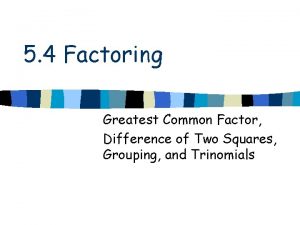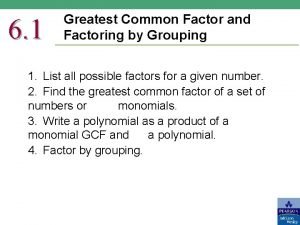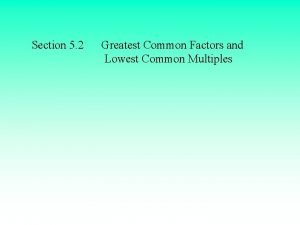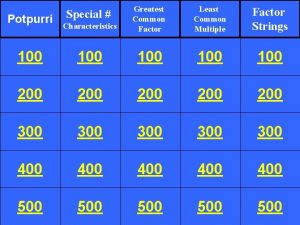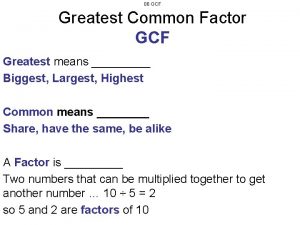4 2 Greatest Common Factor In the Real








- Slides: 8

4. 2 Greatest Common Factor In the Real World Orchestra An orchestra conductor divides 48 violinists, 24 violists, and 36 cellists into ensembles. Each ensemble has the same number of each instrument. What is the greatest number of ensembles that can be formed? How many violinists, violists, and cellists will be in each ensemble?

4. 2 Greatest Common Factor In the Real World Orchestra An orchestra conductor divides 48 violinists, 24 violists, and 36 cellists into ensembles. Each ensemble has the same number of each instrument. What is the greatest number of ensembles that can be formed? How many violinists, violists, and cellists will be in each ensemble? A whole number that is a factor of two or more nonzero whole numbers is called a common factor. The greatest of the common factors is called the greatest common factor (GCF). One way to find the greatest common factor of two or more numbers is to make a list of all the factors of each number and identify the greatest number that is on every list.

Greatest Common Factor 4. 2 EXAMPLE 1 Making a List to Find the GCF In the previous slide, the greatest number of ensembles that can be formed is given by the greatest common factor of 48, 24, and 36. Factors of 48: 1, 2, 3, 4, 6, 8, 12 12, 16, 24, 48 Factors of 24: 1, 2, 3, 4, 6, 8, 12 12, 24 The common factors are 1, 2, 3, 4, 6, and 12. The GCF is 12. Factors of 36: 1, 2, 3, 4, 6, 9, 12 12, 18, 36 ANSWER The greatest common factor of 48, 24, and 36 is 12. So, the greatest number of ensembles that can be formed is 12. Then each ensemble will have 4 violinists, 2 violists, and 3 cellists.

4. 2 Greatest Common Factor Using Prime Factorization Another way to find the greatest common factor of two or more numbers is to use the prime factorization of each number. The product of the common prime factors is the greatest common factor.

Greatest Common Factor 4. 2 EXAMPLE 2 Using Prime Factorization to Find the GCF Find the greatest common factor of 180 and 126 using prime factorization. Begin by writing the prime factorization of each number. 180 126 10 18 2 63 2 5 2 9 2 3 21 2 5 2 3 3 2 3 3 7 180 = 2 2 3 3 5 126 = 2 3 3 7

Greatest Common Factor 4. 2 EXAMPLE 2 Using Prime Factorization to Find the GCF Find the greatest common factor of 180 and 126 using prime factorization. Begin by writing the prime factorization of each number. 180 126 10 18 2 63 2 5 2 9 2 3 21 2 5 2 3 3 2 3 3 7 ANSWER 180 = 2 2 3 3 5 126 = 2 3 3 7 The common prime factors of 180 and 126 are 2, 3, and 3. So, the greatest common factor is 2 3 2 = 18.

4. 2 Greatest Common Factor Relatively Prime Two or more numbers are relatively prime if their greatest common factor is 1.

4. 2 Greatest Common Factor Relatively Prime Two or more numbers are relatively prime if their greatest common factor is 1. EXAMPLE 3 Identifying Relatively Prime Numbers Tell whether the numbers are relatively prime. 28, 51 15, 45 Factorsofof 28: 15: 1, 1, 2, 3, 4, 5, 7, 1514, 28 Factorsofof 45: 51: 1, 1, 3, 3, 5, 17, Factors 9, 51 15, 45 ANSWER Becausethe the. GCFisis 1, 3, 2815 and 4551 are arerelatively not relatively prime. 1. The GCF is 3.

